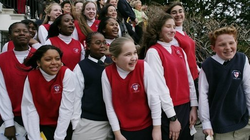Last week, Slate published a critique of Sweden’s school choice program that managed to be both inaccurate and fallacious. That is to say, several of its key premises are false, and its conclusion wouldn’t follow even if they were true.
The gist of the piece is that Sweden’s private schools, and the parental choice program that pays for them, “have thrown Swedish education off course,” causing its international test scores to fall. Slate then claims that Finland is “consistently a top performer” without having a private school choice program. Therefore, it argues, Americans should not allow market freedoms and incentives in K-12 education.
Slate does get at least two things right: Sweden does have a private school choice program, introduced in 1992; and that nation’s scores have been declining on the PISA test since the year 2000. But beyond that, Slate veers quickly into error and sophistry.
First, it claims that “more Swedish students go to privately run (and mostly for-profit) schools than in any other developed country on earth.” In fact, neither of these claims is true. Taking the parenthetical claim first, according to the most recent data of which I am aware (from 2012), the majority of Swedish private schools are non-profit (in Swedish, “Ideella”).
As for overall private sector enrollment among industrialized countries, we can consult the OECD, an association of 34 industrialized nations that administers the PISA test.
On average across OECD countries… 14% of students attend government-dependent [i.e., gov’t-funded] private schools…. In Sweden, the share of students in private schools increased significantly over the past decade from 4% in 2003 to 14% in 2012…. This brings the share of students in private schools close to the OECD average.
Slate, in other words, is badly mistaken on this point. How badly? Here are the top five industrialized countries by share of private school enrollment, according to the OECD’s 2012 PISA database:
| Belgium | 68.4 |
| Netherlands | 67.6 |
| Ireland | 58.2 |
| Korea | 47.5 |
| UK | 45.2 |
At 14 percent overall, Sweden doesn’t come close. Moreover, the PISA test is administered to 15-year-olds, and at that age Swedish students are still in “grundskola” (the compulsory elementary grades). In those grades, private school students made up only 13 percent of enrollment in 2012. That, it’s worth noting, is only about three percentage points higher than the current figure for the United States—and indeed lower than the U.S. figure of 1960. And yet this tiny minority of private school students are purported to have “thrown Swedish education off course.” Would anyone make the same claim about U.S. private schools today, or under JFK?
And how, exactly, are Sweden’s private voucher schools supposed to have wreaked this havoc on their nation’s PISA performance? Are they performing so badly as to have pulled down the nationwide average? Actually, no, they consistently outperform the public schools. And even if they had drawn higher-scoring students out of the public schools, they enroll too few total students for that to explain the dramatic drop in public school PISA scores—particularly since the public school decline was already visible by 2003, at which point private school enrollment was still only 4 percent.
Next, the piece tries to find footing for its argument by touting Finland, which has relatively few private schools, claiming that it is “consistently near the top of the PISA rankings.” Regrettably for Slate, that footing is in its mouth. On the most recent PISA test, Finland ranked 12th in mathematics (the focus of the test in 2012), which rather stretches the definition of the word “top.” (The full PISA results summary can be found here).
Nor is Finland consistently a top scorer on the other international test known as TIMSS. While PISA is a test of everyday knowledge, TIMSS measures performance on the sorts of academic disciplines students are normally taught in school, and which are often required for success in higher education. Finland’s curriculum is unusual in that it is well aligned with the basic PISA content, but weaker in its coverage of the more advanced academics tested by TIMSS, particularly in mathematics. That is perhaps one reason why Finland’s latest 8th grade TIMSS mathematics scores were statistically indistinguishable from those of the United States, and nearly one hundred points below those of high-performers like Korea.
This is particularly awkward for Slate’s claim that having many students enrolled in private schools is a liability. As noted in the table above, Korea’s private K-12 enrollment is nearly four times larger than that of Sweden and more than a dozen times larger than that of Finland. On top of this, Korea also has a massive, for-profit private tutoring sector, frequented by the majority of students.
Nevertheless, Slate claims that competition from private schools may have led to “a race to the bottom” in Sweden. But since Sweden’s private schools score higher on PISA than its public schools, it’s not obvious what this might mean. Could Slate be claiming that the performance of private schools has been declining faster than that of public schools? If so, the reverse is true. Since the PISA test was first administered in 2000, Swedish private schools lost a scant 6 points overall. The nation’s public schools lost 34 points over the same period—nearly six times as much. If one of these sectors is leading a race to the bottom, it’s not the private sector.
Or perhaps Slate is claiming that, faced with the new competition from private schools, Sweden’s public schools are falling to pieces and giving up. It’s not clear why that might be the case, but it’s a testable hypothesis. Not only testable, but already tested. In 2012, Anders Böhlmark and Mikael Lindahl performed a time-series regression analysis on the educational outcomes of virtually every 9th grade student in Sweden, across multiple cohorts. They found that “an increase in the share of independent-school students improves average performance at the end of compulsory school as well as long-run educational outcomes.” In other words, Slate’s claim is directly contradicted by the evidence that it did not bother to examine. Competition from Sweden’s private school choice program has a positive effect on student achievement in both public and private schools.
So, Slate is consistently wrong about the nature, size, and effects of Sweden’s private school sector and the competition it has engendered. But what if it were right about all these things? Would we then be correct in accepting its conclusion? Or, given that Slate is precisely backward about nearly every aspect of the Swedish educational experience, should we assume on the Swedish evidence alone that school choice is good? Of course not. There are too many other factors affecting educational performance outside of school choice policy for the results of a single program to be conclusive. Economic, cultural, and demographic factors are all known to affect those outcomes, as are a panoply of educational policies besides school choice, such as curriculum, testing, staffing, discipline, etc.
To isolate the intrinsic merits of a policy it is necessary to eliminate the confounding effects of those other factors. One way to do that is to compare different types of school choice policies operating side-by-side within countries. Another is to look for consistent patterns in the outcomes associated with a given policy across many different nations and time periods. Still another is to directly assess and control for the confounding factors. The Slate piece does none of these things—it not only shoots from the hip, it shoots while its intellectual weapon is still holstered.
What is most disappointing about the Slate piece is that it was written by a Harvard-trained, Columbia University economist who not only should know better, but demonstrably does know better. He has, for instance, co-authored a sensible working paper attempting to measure the financial gains enjoyed by Indian politicians—a paper that takes great pains to collect accurate data and to minimize the effects of confounding factors. Education policy, it seems to me, is no less deserving of such thoughtful treatment. Misinformed, fallacious nonsense such as this Slate piece can do serious harm to the education of children.
– Andrew J. Coulson
Andrew J. Coulson directs the Cato Institute’s Center for Educational Freedom and is author of the study: Comparing Public, Private, and Market Schools: The International Evidence, and the book Market Education: The Unknown History.




